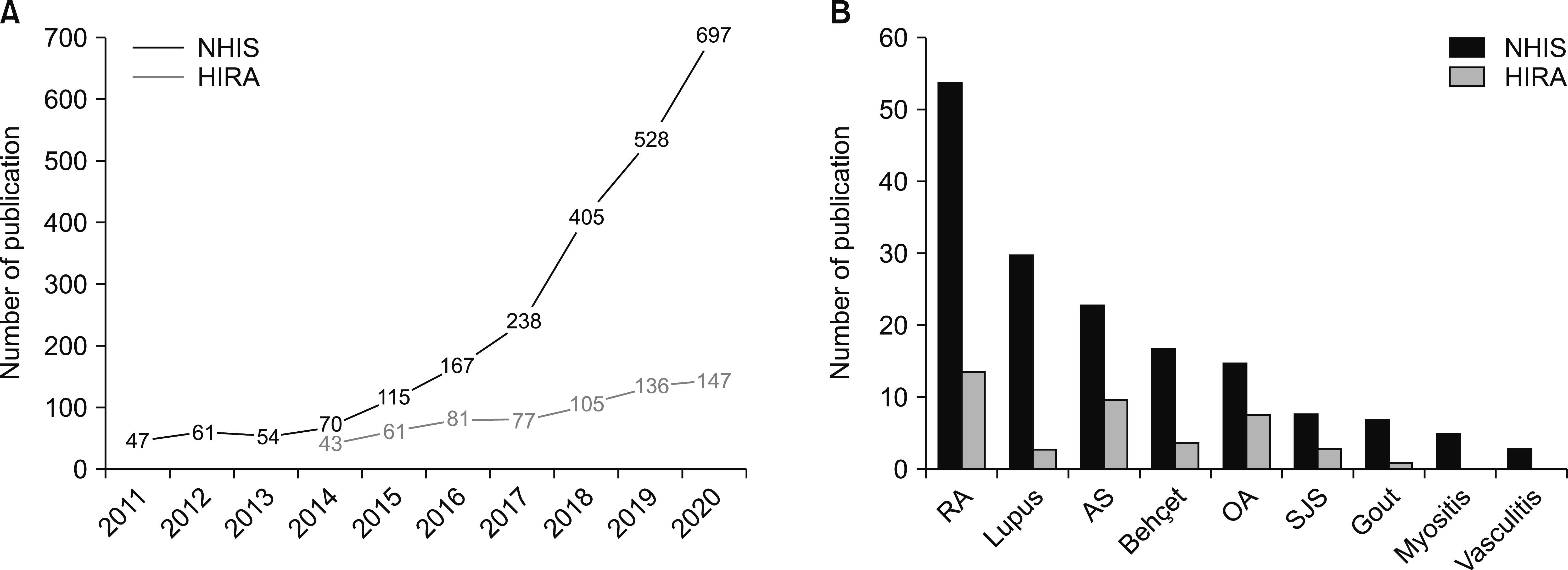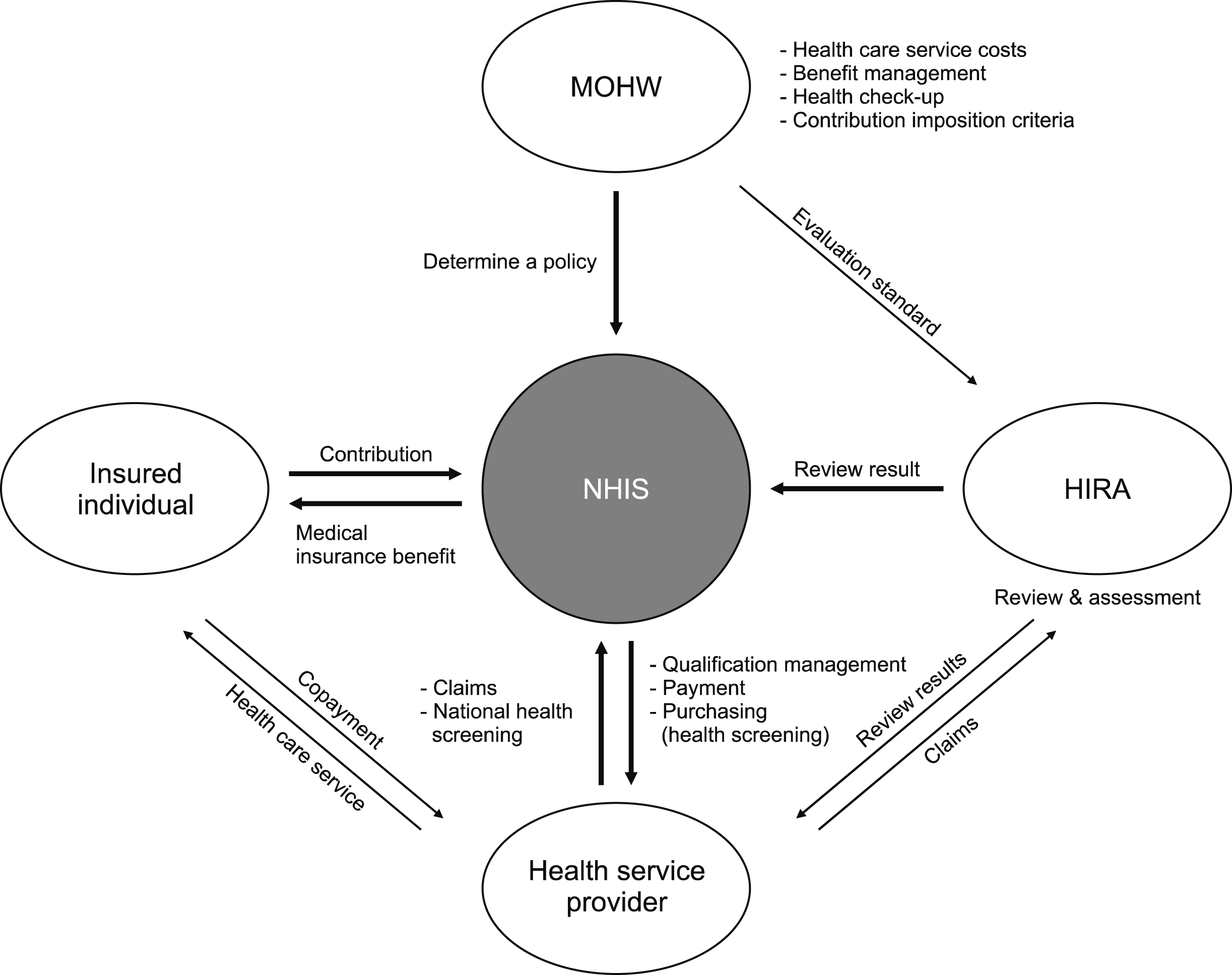1. Ng B, Chu A. 2014; Factors associated with methotrexate dosing and therapeutic decisions in veterans with rheumatoid arthritis. Clin Rheumatol. 33:21–30. DOI:
10.1007/s10067-013-2353-9. PMID:
23934386.

2. Hsing AW, Ioannidis JP. 2015; Nationwide population science: lessons from the Taiwan National Health Insurance Research Database. JAMA Intern Med. 175:1527–9. DOI:
10.1001/jamainternmed.2015.3540. PMID:
26192815.
3. Lin LY, Warren-Gash C, Smeeth L, Chen PC. 2018; Data resource profile: the National Health Insurance Research Database (NHIRD). Epidemiol Health. 40:e2018062. DOI:
10.4178/epih.e2018062. PMID:
30727703. PMCID:
PMC6367203.

5. Song SO, Jung CH, Song YD, Park CY, Kwon HS, Cha BS, et al. 2014; Background and data configuration process of a nationwide population-based study using the Korean national health insurance system. Diabetes Metab J. 38:395–403. DOI:
10.4093/dmj.2014.38.5.395. PMID:
25349827. PMCID:
PMC4209354.

8. Seong SC, Kim YY, Khang YH, Park JH, Kang HJ, Lee H, et al. 2017; Data resource profile: the National Health Information Database of the National Health Insurance Service in South Korea. Int J Epidemiol. 46:799–800. DOI:
10.1093/ije/dyw253. PMID:
27794523. PMCID:
PMC5837262.
9. Lee CH, Sung NY. 2011; The prevalence and features of Korean gout patients using the National Health Insurance Corporation database. J Rheum Dis. 18:94–100. DOI:
10.4078/jrd.2011.18.2.94.

10. Kim JA, Yoon S, Kim LY, Kim DS. 2017; Towards actualizing the value potential of Korea Health Insurance Review and Assessment (HIRA) data as a resource for health research: strengths, limitations, applications, and strategies for optimal use of HIRA data. J Korean Med Sci. 32:718–28. DOI:
10.3346/jkms.2017.32.5.718. PMID:
28378543. PMCID:
PMC5383602.

11. Lee J, Lee JS, Park SH, Shin SA, Kim K. 2017; Cohort profile: the National Health Insurance Service-National Sample Cohort (NHIS-NSC), South Korea. Int J Epidemiol. 46:e15. DOI:
10.1093/ije/dyv319. PMID:
26822938.

12. Kim YI, Kim YY, Yoon JL, Won CW, Ha S, Cho KD, et al. 2019; Cohort Profile: National health insurance service-senior (NHIS-senior) cohort in Korea. BMJ Open. 9:e024344. DOI:
10.1136/bmjopen-2018-024344. PMID:
31289051. PMCID:
PMC6615810.

13. Seong SC, Kim YY, Park SK, Khang YH, Kim HC, Park JH, et al. 2017; Cohort profile: the National Health Insurance Service-National Health Screening Cohort (NHIS-HEALS) in Korea. BMJ Open. 7:e016640. DOI:
10.1136/bmjopen-2017-016640. PMID:
28947447. PMCID:
PMC5623538.

14. Kim YY, Hong HY, Cho KD, Park JH. 2019; Family tree database of the National Health Information Database in Korea. Epidemiol Health. 41:e2019040. DOI:
10.4178/epih.e2019040. PMID:
31679329. PMCID:
PMC6928464.

15. Lee CH, Sung NY, Lee J, Bae SC. 2013; Factors associated with gout in South Koreans: analysis using the National Health Insurance Corporation and the National Health Screening Exam databases. Clin Rheumatol. 32:829–37. DOI:
10.1007/s10067-013-2183-9. PMID:
23397143.

16. Kwak SG, Park SH, Kim JY. 2021; Incidence and prevalence of juvenile systemic lupus erythematosus in Korea: data from the 2017 National Health Claims Database. J Rheumatol. 48:258–61. DOI:
10.3899/jrheum.191186. PMID:
32358155.

17. Chung MK, Park JS, Lim H, Lee CH, Lee J. 2021; Incidence and prevalence of systemic lupus erythematosus among Korean women in childbearing years: a nationwide population-based study. Lupus. 30:674–9. DOI:
10.1177/0961203320984845. PMID:
33460342.

18. Hong M, Moon DS, Chang H, Lee SY, Cho SW, Lee KS, et al. 2018; Incidence and comorbidity of reactive attachment disorder: based on National Health Insurance claims data, 2010-2012 in Korea. Psychiatry Investig. 15:118–23. DOI:
10.30773/pi.2017.11.01. PMID:
29475227. PMCID:
PMC5900398.
19. Won S, Cho SK, Kim D, Han M, Lee J, Jang EJ, et al. 2018; Update on the prevalence and incidence of rheumatoid arthritis in Korea and an analysis of medical care and drug utilization. Rheumatol Int. 38:649–56. DOI:
10.1007/s00296-017-3925-9. PMID:
29302803.

20. Kang EH, Choi HK, Shin A, Lee YJ, Lee EB, Song YW, et al. 2019; Comparative cardiovascular risk of allopurinol versus febuxostat in patients with gout: a nation-wide cohort study. Rheumatology (Oxford). 58:2122–9. DOI:
10.1093/rheumatology/kez189. PMID:
31098635.

21. Nam JH, Lee C, Kim N, Park KY, Ha J, Yun J, et al. 2019; Impact of continuous care on health outcomes and cost for type 2 diabetes mellitus: analysis using National Health Insurance cohort database. Diabetes Metab J. 43:776–84. DOI:
10.4093/dmj.2018.0189. PMID:
31701688. PMCID:
PMC6943271.

22. Choi J, Kim HJ, Lee J, Cho S, Ko MJ, Lim YS. 2019; Risk of hepatocellular carcinoma in patients treated with entecavir vs tenofovir for chronic hepatitis B: a Korean nationwide cohort study. JAMA Oncol. 5:30–6. DOI:
10.1001/jamaoncol.2018.4070. PMID:
30267080. PMCID:
PMC6439769.
23. Cho WK, Lee NY, Han K, Suh BK, Park YG. 2020; The population prevalence, associations of congenital heart defect and mortality risk for Down's syndrome in South Korea based on National Health Insurance Service (NHIS) data. Clin Epidemiol. 12:519–25. DOI:
10.2147/CLEP.S251637. PMID:
32547243. PMCID:
PMC7266305.
24. Gavrielov-Yusim N, Friger M. 2014; Use of administrative medical databases in population-based research. J Epidemiol Community Health. 68:283–7. DOI:
10.1136/jech-2013-202744. PMID:
24248997.
25. Kimm H, Yun JE, Lee SH, Jang Y, Jee SH. 2012; Validity of the diagnosis of acute myocardial infarction in Korean national medical health insurance claims data: the Korean heart study (1). Korean Circ J. 42:10–5. DOI:
10.4070/kcj.2012.42.1.10. PMID:
22363378. PMCID:
PMC3283749.

26. Park JS, Kang M, Song JS, Lim HS, Lee CH. 2020; Trends of gout prevalence in South Korea based on medical utilization: a National Health Insurance Service Database (2002∼2015). J Rheum Dis. 27:174–81. DOI:
10.4078/jrd.2020.27.3.174.

27. Kim JW, Kwak SG, Lee H, Kim SK, Choe JY, Park SH. 2017; Prevalence and incidence of gout in Korea: data from the national health claims database 2007-2015. Rheumatol Int. 37:1499–506. DOI:
10.1007/s00296-017-3768-4. PMID:
28676911.

30. Kim JW, Kwak SG, Park SH. 2018; Prescription pattern of urate-lowering therapy in Korean gout patients: data from the national health claims database. Korean J Intern Med. 33:228–9. DOI:
10.3904/kjim.2016.429. PMID:
28823114. PMCID:
PMC5768547.

31. Fetter RB, Freeman JL. 1986; Diagnosis related groups: product line management within hospitals. Acad Manage Rev. 11:41–54. DOI:
10.5465/amr.1986.4282622. PMID:
10311457.

32. Seo HY, Yoon SJ, Kim EJ, Oh IH, Lee YH, Kim YA. 2013; The economic burden of rheumatic heart disease in South Korea. Rheumatol Int. 33:1505–10. DOI:
10.1007/s00296-012-2554-6. PMID:
23239034.






 PDF
PDF Citation
Citation Print
Print




 XML Download
XML Download